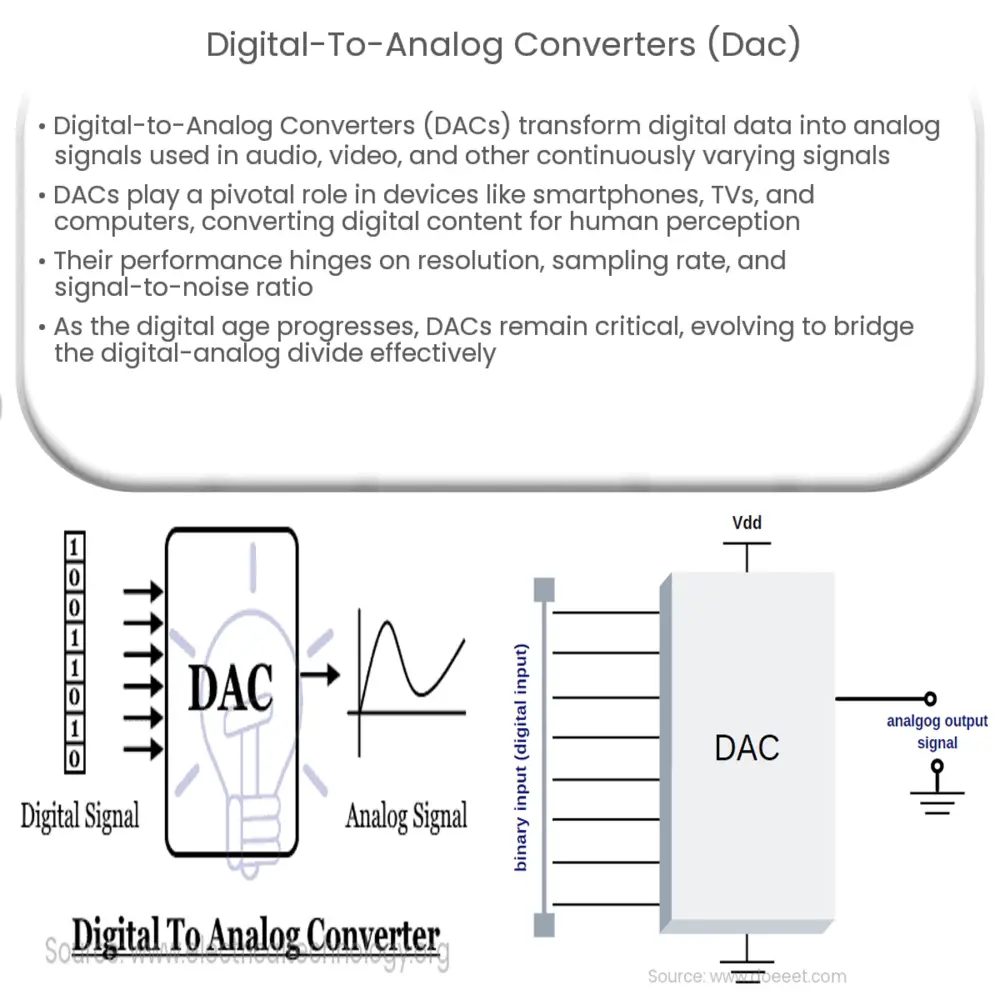Explore the role and functionality of Digital-to-Analog Converters (DACs), their operation methods, and applications in modern electronics.

Understanding Digital-to-Analog Converters (DACs)
Digital-to-Analog Converters (DACs) are integral components of our digital world, operating behind the scenes in numerous electronic devices. But what are DACs, and how do they work? This article aims to provide an insight into the role and functionality of DACs.
What is a Digital-to-Analog Converter (DAC)?
A
For instance, when you’re listening to music on your digital device, a DAC is hard at work, converting digital data into analog audio signals, which are then amplified and sent to your headphones or speakers. This allows you to perceive the sound.
How Does a DAC Work?
DACs work by generating an analog signal that corresponds to the binary code input. There are various methods that a DAC might use to perform this conversion. We’ll take a look at some of the most common ones:
Binary-Weighted DACs: These are one of the simplest forms of DACs. Here, each binary input bit has a corresponding analog voltage that is weighted in binary format. However, due to the binary-weighted resistors required, this design becomes impractical for higher resolution DACs.R-2R Ladder DACs: This type of DAC is also known as a binary ladder DAC. It uses a network of resistors in a repeating pattern (a ladder), where each resistance is double (2R) the value of the resistance before it (R). This design provides a more practical and economical solution for high-resolution DACs.
It’s essential to remember that the output signal’s quality relies heavily on the DAC’s precision, determined by its resolution, sampling rate, and bit rate. The better these parameters, the more accurately the DAC can represent the original digital data as an analog signal.
The Role of DACs in Modern Electronics
DACs have become integral components in many modern electronic devices. Below, we highlight a few key applications:
Audio and Video Devices: DACs are fundamental to audio and video devices, including smartphones, digital televisions, and audio players. They convert digital audio and video data into analog signals that our eyes and ears can perceive.Communication Systems: In communication systems, DACs transform digitally encoded information into analog signals for transmission over various media.
Control Systems: DACs also find their use in control systems such as those used in industrial automation. For instance, in a digital temperature controller, the DAC converts digital temperature data to control an analog heating element.Computers: Every computer uses DACs in its graphics card to convert digital video data into analog signals that are displayed on the monitor.
DAC Specifications and Performance
There are several specifications that are important when considering a DAC’s performance:
Resolution: This is the number of possible output levels that the DAC can produce and is often measured in bits. For example, a 16-bit DAC has 65,536 (216) possible output levels.Sampling Rate: This is the frequency at which the DAC updates the output. The higher the sampling rate, the better the DAC’s ability to recreate the original signal without loss.Signal-to-Noise Ratio (SNR): This is a measure of the amount of desired signal compared to the level of noise signals. A higher SNR means a clearer output signal.
Conclusion
In conclusion, Digital-to-Analog Converters (DACs) play a crucial role in our increasingly digital world, bridging the gap between the digital and analog realms. They serve as essential components in a myriad of electronic devices, enabling us to enjoy music, watch videos, communicate, and control automated systems. As digital technology continues to advance, DACs are sure to evolve alongside, ensuring a seamless digital-to-analog conversion process. Therefore, a sound understanding of DACs is beneficial not only for those interested in electronics, but also for anyone keen to understand the digital world that surrounds us.

